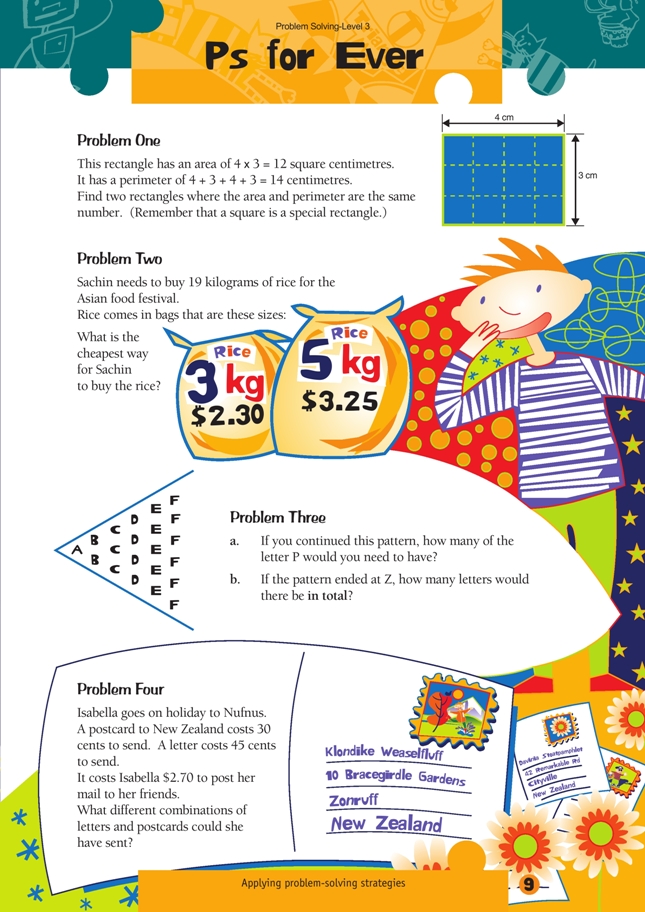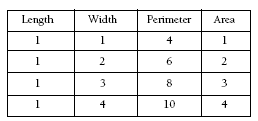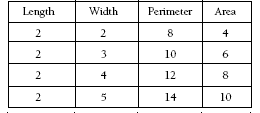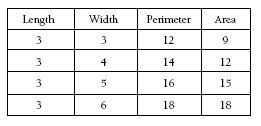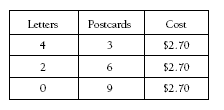These are level 4 measurement, number and algebra problems from the Figure It Out series.
A PDF of the student activity is included.
Click on the image to enlarge it. Click again to close. Download PDF (348 KB)
investigate the relationship between area and perimeter (Problem 1)
solve problems involving proportions (Problem 2)
investigate a sequential pattern (Problem 3)
use multiplication and addition to solve money problems (Problem 4)
Problem One
Students may need squared paper to draw the rectangles they are investigating. Their results can be organised in a table so that they can look for patterns and eliminate possibilities.
Rectangles with two sides of 1 centimetre will always have a perimeter that is greater than the area. Investigating rectangles with lengths of 2 centimetres gives the following results:
The perimeter is always four greater than the area.
Investigating rectangles with lengths of 3 centimetres gives:
So, a 3 x 6 rectangle has equal perimeter and area. Similar reasoning will show that a 4 x 4 rectangle also works.
If students include decimal values for the side lengths, other solutions are possible, such as 2.5 x 10.
Problem Two
Sachin needs 19 kilograms of rice, but the mass of the bags does not allow him to buy the exact amount. Students will need to systematically list the ways in which Sachin could buy at least 19 kilograms and calculate the cost of each way.
Ask students what is the cheapest way of buying other amounts of rice. For example, to buy 15 kilograms, three 5 kilogram bags are cheapest, but to buy 12 kilograms, four 3 kilogram bags are cheaper than three 5 kilogram bags. However, the cheapest way to buy 12 kilograms is one 3 kilogram bag and two 5 kilogram bags.
Problem Three
Students can work with sequential patterns in this problem. Use of relationships can simplify the problem.
For example, using a table gives:
The number of each letter increases by one for each subsequent letter. P is the 16th letter, so there will be 16 of them. Z is letter number 26, so there will be 26 of them. The total number of letters is therefore:
1 + 2 + 3 + 4 + 5 + ... + 22 + 23 + 24 + 25 + 26
These numbers can be paired into numbers that add to 27 (that is, 1 + 26, 2 + 25, 3 + 24, 4 + 23, 5 + 22). There are 13 such pairs, so the total number of letters is 13 x 27 = 351.
Problem Four
Students need to work backwards from the total cost of postage in an organised way.
Three postcards can be sent for the cost of two letters, so other solutions involve decreasing the number of letters by two and increasing the number of postcards by three.
You can set similar problems by varying the total amount paid and the cost of sending each article. For example, “Isabella spent $6 on postage. Letters cost 40 cents to send, and postcards cost 25 cents. How many of each article could she have sent?”
Answers to Problems
1. 4 x 4 and 3 x 6. Other solutions are possible if side lengths with fractions are included, for example, 2.5 x 10.
2. Four 5 kg bags at a cost of $13 (The extra kilogram could be saved for another occasion.)
3. a. 16
b. 351
4. Possible solutions: 9 postcards, 6 postcards and 2 letters, 3 postcards and 4 letters, or 6 letters.
